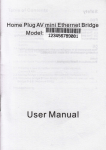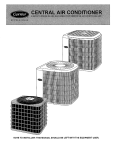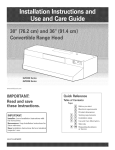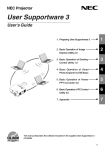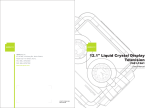Download Owner`s Manual
Transcript
Owner's Manual USER'S INFORMATION MANUAL FOR THE OPERATION AND MAINTENANCE OF YOUR NEW RESIDENTIAL HEAT PUMP Safety Considerations Recognize safety inform;ttion, This is the safety-alert symbol _, When you see this symbol (511the unit and ill instrtlctions (51 manuals, be alert to the potential l\sr personal injury. Understand the signal words DANGER, WARNING, and CAUTION. These words are used with the safety-alert symbol. DANGER identifies the most serious hazards which will result in severe personal injury or death. WARNING signifies hazards which could result in personal injury or death. CAUTION is used to identify unsafe practices which may result in minor personal injury or product and property damage. NOTE is used to highlight suggestions which will result in enhanced installation, reliability, or operation. WARNING: ELECTRICAL SHOCK, FIRE, EXPLOSION, PERSONAL INJURY HAZARD Improper installation, adjustment, alteration, service, maintenance or use could result in personal injury, death, and/or property damage. Consult a qualified installer, service agency, or your distributor or branch for information or assistance. The qualified installer or agency must use factory-authorized kits or accessories when modifying this product. A WARNING: ELECTRICAL SHOCK, UNIT OPERATION AND SAFETY HAZARD Failure to follow this warning could result in personal injury, death, and/or property damage. Read and follow all instructions and warnings, including labels shipped with or attached to unit before ing your new heat pump. IMPORTANT To better protect operat- FACTS your investment and to eliminate unnecessary service calls, • Your heat pump system should never be operated without a clean air filter properly clogged air filter will increase operating costs and shorten the life of the unit, • Supply-air and return-air registers should not be blocked. Drapes, furniture, ing grilles. Restricted airflow lessens the unit's efficiency and life span, familiarize yourself with the following facts: installed. Plan to inspect the filter periodically. and toys are some of the items commonly A found obstruct- • The outdoor unit must have unrestricted airflow, Do not cover the unit, lean anything against it, or stand upon it, Do not allow grass clippings, leaves, or other debris to accumulate around or on top of the unit, Maintain a 12-in, minimum clearance between the outdoor unit and tall grass, vines, shrubs, etc, • Your multipuq?ose indoor thermostat is the control center for your heat pump system.You should lhmiliarize yourself with its proper operation, Attempting to control the system by other means--for instance, switching the electrical supply power ON and OFF--may cause damage to the unit. • During heating, increasing the thermostat more than 2 degrees may cause the supplemental thermostat, Needless use of the supplementary heat reduces potential enelgy savings. heaters to be turned on to satisfy the • You may find that you can maintain grexLter personal comfort by running the fan continuously. Air pockets can fon_n due to the structure of the house, placement of registers, etc. These air pockets may be too cool or wan_n for your liking. Continuous lhn operation minimizes any temperature differences. Also, systems equipped with electronic air clexmers and/or humidifiers offer the added benefits of having the air continuously cleaned year-round, and humidified during the winter season, • Your heat pump will remove humidity from your home during the cooling season, After a few minutes of operation, you should be able to see water trickle from the condensate drain of the indoor cooling coil, Check this occasionally to be sure the drain system is not clogged. Of course, don't expect to see much drainage if you live in a very dry environment, NOTE TO INSTALLER: THIS MANUAL MUST BE LEFT WITH THE EQUIPMENT USER. • During the heating cycle, air from your registers may seem cool. This is because the air is being delivered at a higher velocity and a more constant flow than air supplied by a conventional furnace. Also, your heat pump supplies air at 90 ° to 105°F instead of in sudden bursts of hot air as with a conventional furnace. The air may feel cool because it is slightly lower than your body temperature. However. it is sufficiently warm to keep you comfortable. • Ice or frost will tend to form on the outdoor coil during the winter heating operation.Your heat pump is designed to automatically melt the ice. When in this defrost cycle, it is normal l_r steam or l_g to rise from the outdoor unit. Do not be alarmed! OPERATING YOUR HEAT PUMP The operation of your heat pump system is controlled by the indoor thermostat. You simply adjust the thermostat and it maintains the indoor temperature at the level you select. Refer to the thermostat operating instructions l\_r inl\_rmation on how to operate your thermostat. COOLING CYCLE When operating in the cooling mode, your heat pump will l_l.lnnntil the indoor temperature is lowered to the level you have selected. On extremely hot days, your heat pump will run for longer periods at a time and have shorter off periods than on moderate days. Lowering the setpoint of your thermostat will not cause your heat pump to cool lhstel: The following are typical conditions that add extra heat and/or humidity your home comf_rtable under these conditions: • Entrance doors are frequently • Laundry appliances to your home. Your cooling unit will work longer to keep opened and closed are being operated • A shower is running • More than the usual number of people are present in the home • More than the normal number of electric lights are in use • Drapes are open on the sunny side of the home HEATING CYCLE With HEAT selected, the heating section of your home comfort system will operate until roolll temperature is raised to the level you have selected. Of course, the heating unit will have to operate l\_r longer periods to maintain a coml\)rtable environment on cooler days and nights than on moderate ones. DEFROST CYCLE When your heat pump is providing heat to your home and the outdoor temperature drops below 45°F, moisture may begin to freeze on the surface of the outdoor coil. If allowed to build up, this ice would impede airflow across the coil and reduce the amount of heat absorbed from the outside all: So, to maintain energy-efficient operation, your heat pump has an automatic defrost cycle. The defrost cycle starts at a preset time interval of 90 minutes, although, it may be reset to either 30 or 60 minutes. at the preset time only if the ice is sufficient to interfere with normal heating operation. After the ice is melted from the outdoor back to normal heating operation. coil, or alter a maximum Do not be alarmed if steam or fog appears at the outdoor into a mist in the cold outside all; Defrost will start of 10 minutes in the defrost mode, the unit will automatically unit during the defrost cycle. Water vapor from the melting ice may condense During certain weather conditions such as heavy snow and freezing rain it is not uncommon for ice to build up on the outdoor grille. This is normal l\_r these weather conditions. Do not attempt to remove the ice from the outdoor unit grille. This condition not affect the proper function of the unit and will clear within a few days. EMERGENCY unit will HEAT The EMERGENCY HEAT setting on your thermostat home coml\_rt system. Operation of the EMERGENCY the heat pump, or if the heat pump malfunctions. refers to any supplementary heating appliance that may be included in your HEAT source may be required if heating demands exceed the capacity of During the heating season, switch to EMERGENCY HEAT minutes for any reason (i.e., power outage). Leave the switch during which the power was off: It isn't necessary to exceed leave the switch in the EMERGENCY HEAT position for 8 NOTE: switch The EMERGENCY HEAT switch is effective if the electricity to your outdoor unit has been off f_r more than 30 in the EMERGENCY HEAT mode f_r an amount of time equal to that 12 hours. If you cannot determine how long the power has been off, hours. only when HEAT or AUTO is selected. PERFORMING ROUTINE MAINTENANCE With the proper maintenance and care, your heat pump unit will operate economically and dependaMy. Maintenance can be accomplished easily by referring to the following directions. However, bef_le performing maintenance, consider these important safety precautions. WARNING: ELECTRICAL SHOCK HAZARD Failure to follow this warning could result in personal injury, death. Disconnect all electrical power to the heat pump before removing access panels to perform maintenance. Disconnect power to both the indoor and outdoor units. Note: There may be more than 1 electrical disconnect switch. CAUTION: CUT HAZARD Failure to follow this caution may result in personal injury. Although special care has been taken to minimize sharp edges in the construction of your unit. Be extremely careful when handling parts or reaching into the unit. Use care and wear appropriate protective clothing and gloves when handling parts. CHECKTHE AIR FILTER A dirty air filter will cause excessive straiu ou the conlpressor aud blower nlotor. This cau cause the compoueuts to overheat aud automatically shut down. In the extreme, the components will fail and need to be replaced. To avoid inefficient or failed operation of your unit, CHECK THE FILTER(S) EVERY 3 TO 4 WEEKS. Replace filter(s) when necessary, or clean the filter(s) if you have the washaMe type. Disposable filters should be replaced by silnilal: new filters of the same dimensions. Reusable, washable filters should be washed in a solution of cold water and mild detergent, then rinsed and thoroughly dried. THE FILTER MUST BE COMPLETELY DRY BEFORE BEING REINSTALLED. To avoid prolonged shutdown of your unit while a filter is drying, you should have an extra filter on hand. This would allow you to rotate between the two filters with minimal downtime f_r your coml\_rt system. Extra filters may be purchased from your dealel: There are no filters in the outdoor unit of a split system. If your indoor unit is a gas or oil furnace, refer to your furnace User's Manual f_r filter location and procedures for replacement or cleaning. If your system includes an indoor fan coil unit, the filter may be located in the unit where it connects with the return-air duct or plenum. (See Fig. 1.) Remove the filter cover plate by sliding latches toward center of plate. Lift filter to clear lower flange. Filter is springloaded and will pop out. Reinstall filter, being certain to secure filter behind lower flange. When reinstalling cover plate, secure plate behind upper flange then slide tabs outward. \\ \ Fig. 1--Removing Filter from Fan Coil Unit The indoor tim coil unit may be located filter by removing the return air grille. in the attic. In this instance the filter may be located behind the return air grille. Access the BEFORE YOU REQUEST BEFORE A SERVICE YOU CALL FOR SERVICE, CALL CHECK • Check the iudoor aud outdoor discouuect switches. Verify FOR THESE EASILY SOLVED PROBLEMS: that circuit breakers are ON or that fuses have uot blowu. • Check f_ir sufficient airflow. Check the air filter(s) for any accumulations sure grilles are opeu aud uuobstructed. of dirt, Check f_ir blocked return-air or supply-air grilles. Be • Check the settings on your indoor thermostat. If you desire cooling, see that the temperature setting is set below room temperature and COOL or AUTO is selected. If you require warmth, be sure the temperature setting is set above room temperature and HEAT or AUTO is selected. The FAN switch should be set at ON l\_r continuous blower operation or AUTO if you wish the blower to function only while the unit is operating. If your comf_rt system still t_ailsto operate, coutact your serviciug dealer f_ir troubleshootiug aud repairs. Specify your apparent problem, and state the model aud serial lmmbers of your equiplnent. With this iuformation, your dealer may be able to offer helpful suggestions over the phoue or save valuable time through kuowledgeable preparatioll l\_r the service call. REGULAR DEALER MAINTENANCE In addition to the routine maintenance that you perform, your home comfort system should be inspected regularly by a properly trained service technician. The inspection (preferably twice each year, but at least once every year) should include the f_llowing: • Routine inspection ofair filter(s). Replacement orcleaning as required. • Inspection and cleaning of the blower wheel, housing, and motor as required. • Inspection and, if required, cleaning of indoor and outdoor coils. • Inspection of the indoor coil drain pan, plus the primary and secondary drain lines. If supplied, the auxiliary drain pan and line should be inspected at this time. Service should include cleaning if required. • A check ofall electrical wiring and connections. • A check f_r secure physical connections of individual components within units. • Operational check of the heat pump system to determine actual working condition. Necessary repair and/or adjustment should be perf_rmed at this time. Your servicing dealer may offer an economical service contract that covers seasonal inspections. Ask for further details. FOR THE RECORD Record the model, product, aud serial uumbers of your uew equipmeut. This illt\_rlnatiou, facts requested, will be uecessary should you ever require ilfformatiou or service. © Payne Heating & Cooling Systems 7310 W. Morris St. Indianapolis, IN 46231 Manufacturer or designs without notice and obligations reserves the right to change at any time, specifications Printed in U.S.A. 4 aloug with the other ready-refereuce edition date: 03/06 Catalog No, OG-PH 10-05 Replaces: New




